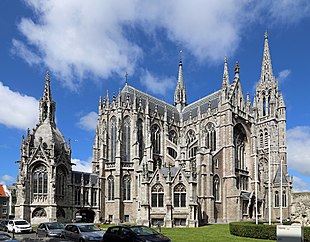
Gothic Revival (also referred to as Victorian Gothic or neo-Gothic) is an architectural movement that after a gradual build-up beginning in the second half of the 17th century became a widespread movement in the first half of the 19th century, mostly in England. Increasingly serious and learned admirers sought to revive medieval Gothic architecture, intending to complement or even supersede the neoclassical styles prevalent at the time. Gothic Revival draws upon features of medieval examples, including decorative patterns, finials, lancet windows, and hood moulds. By the middle of the 19th century, Gothic Revival had become the pre-eminent architectural style in the Western world, only to begin to fall out of fashion in the 1880s and early 1890s.
The Gothic Revival movement's roots are intertwined with philosophical movements associated with Catholicism and a re-awakening of high church or Anglo-Catholic belief concerned by the growth of religious nonconformism. The "Anglo-Catholic" tradition of religious belief and style became known for its intrinsic appeal in the third quarter of the 19th century. Gothic Revival architecture varied considerably in its faithfulness to both the ornamental styles and construction principles of its medieval ideal, sometimes amounting to little more than pointed window frames and touches of neo-Gothic decoration on buildings otherwise created on wholly 19th-century plans, using contemporary materials and construction methods; most notably, this involved the use of iron and, after the 1880s, steel in ways never seen in medieval exemplars.

In parallel with the ascendancy of neo-Gothic styles in 19th century England, interest spread to the rest of Europe, Australia, Africa and the Americas; the 19th and early 20th centuries saw the construction of very large numbers of Gothic Revival structures worldwide. The influence of Revivalism had nevertheless peaked by the 1870s. New architectural movements, sometimes related, as in the Arts and Crafts movement, and sometimes in outright opposition, such as Modernism, gained ground, and by the 1930s the architecture of the Victorian era was generally condemned or ignored. The later 20th century saw a revival of interest, manifested in the United Kingdom by the establishment of the Victorian Society in 1958.